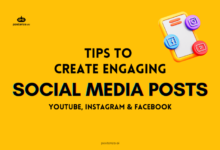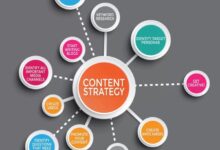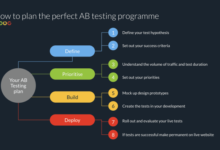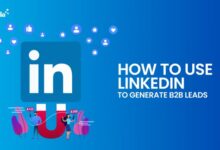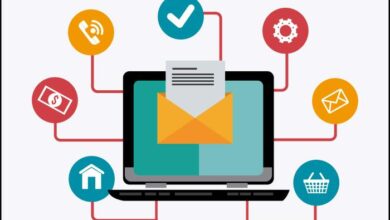
Creating a successful lead generation funnel takes center stage in this comprehensive guide, diving deep into the intricacies of crafting an effective strategy to attract and convert leads. From understanding your target audience to implementing compelling lead magnets and optimizing funnel performance, this topic explores every aspect crucial for success.
Introduction to Lead Generation Funnel: Creating A Successful Lead Generation Funnel
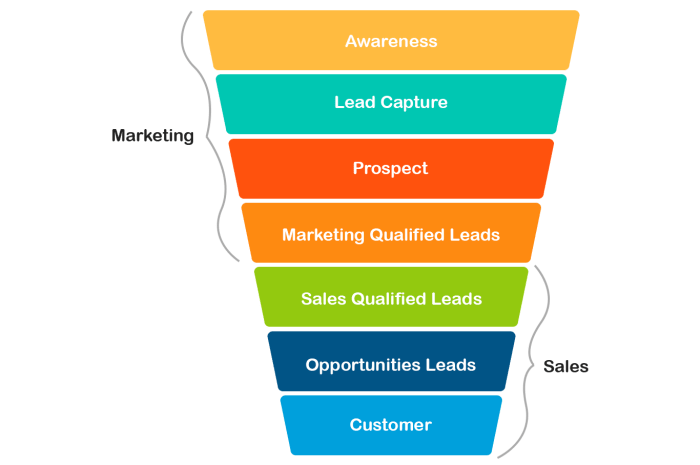
Lead generation funnel is a crucial aspect of marketing that guides potential customers through a series of stages towards making a purchase. It helps businesses to capture, nurture, and convert leads into loyal customers. The key stages of a successful lead generation funnel typically include awareness, interest, consideration, intent, evaluation, and purchase.
Key Stages of a Successful Lead Generation Funnel
- Awareness: At this stage, businesses attract the attention of potential customers and make them aware of their products or services through marketing campaigns, social media, and content.
- Interest: Once awareness is created, businesses aim to generate interest in their offerings by providing valuable information, engaging content, and solutions to customers’ problems.
- Consideration: In this stage, potential customers evaluate the benefits of the products or services offered by the businesses and compare them with competitors to make an informed decision.
- Intent: Customers show intent to make a purchase by showing interest in specific products, requesting quotes, or signing up for trials or demos.
- Evaluation: Businesses provide additional information, testimonials, reviews, and case studies to help customers finalize their decision and overcome any doubts or objections.
- Purchase: The final stage involves converting leads into customers by encouraging them to make a purchase, whether through online transactions, in-store visits, or other methods.
Examples of Businesses Utilizing Lead Generation Funnels
- HubSpot: HubSpot is a prime example of a company that effectively uses lead generation funnels through its inbound marketing strategies, free tools, and educational content to attract, engage, and convert leads into customers.
- Zapier: Zapier, a workflow automation tool, excels in lead generation by offering valuable resources, webinars, and product demos to guide potential customers through the funnel and drive conversions.
- Salesforce: Salesforce, a leading CRM platform, implements a robust lead generation funnel by leveraging targeted ads, personalized content, and email marketing campaigns to nurture leads and drive sales.
Understanding Target Audience
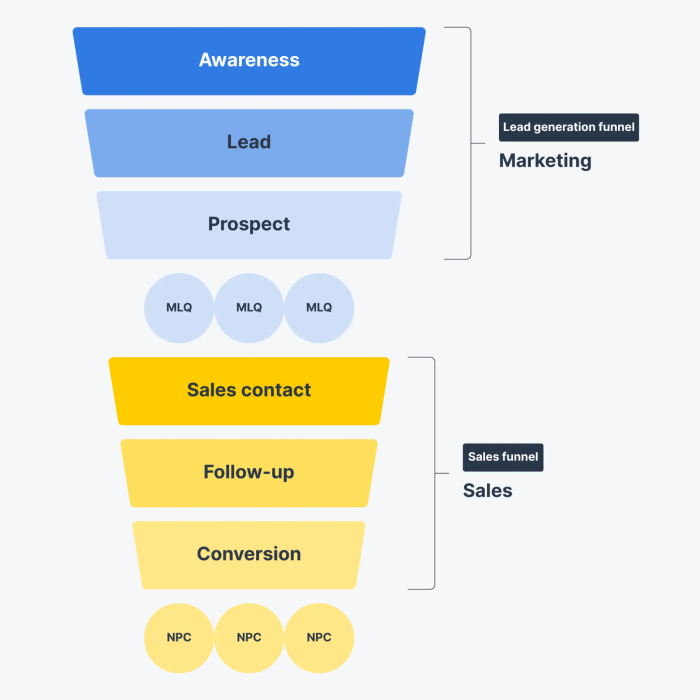
Understanding your target audience is crucial for the success of a lead generation funnel. By knowing who your audience is, you can tailor your content and marketing strategies to effectively capture their attention and convert them into leads. Here, we will discuss the significance of knowing your target audience, how to identify and segment them, and strategies for tailoring content to different audience segments within the funnel.
Identifying and Segmenting Target Audiences
Identifying and segmenting your target audience involves breaking down your overall audience into smaller groups based on demographics, behavior, interests, and other factors. This allows you to create more personalized and targeted marketing campaigns. Here are some key steps to effectively identify and segment your target audiences:
- Conduct market research to gather data on your audience’s demographics, such as age, gender, location, income level, etc.
- Use analytics tools to track user behavior and engagement with your content to understand their preferences and interests.
- Create buyer personas based on your research findings to represent different segments of your target audience.
- Segment your audience based on common characteristics or behaviors to tailor your marketing messages accordingly.
Tailoring Content to Different Audience Segments
Once you have identified and segmented your target audiences, it’s essential to tailor your content to resonate with each segment throughout the lead generation funnel. Here are some strategies for tailoring content to different audience segments:
- Create personalized content that addresses the specific needs and pain points of each audience segment.
- Use targeted messaging and language that speaks directly to the interests and preferences of each segment.
- Utilize different content formats, such as videos, blogs, infographics, etc., to cater to diverse audience preferences.
- Implement A/B testing to optimize your content based on the performance and engagement of each audience segment.
Creating Compelling Lead Magnets
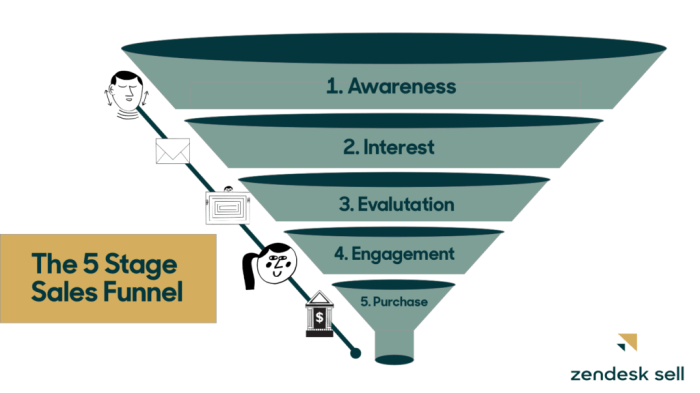
Lead magnets are essential tools in attracting and capturing potential leads in your funnel. They offer value to your target audience in exchange for their contact information, helping to build relationships and move them through the sales process. Here, we will discuss the types of lead magnets that work best at each stage of the funnel, tips for designing and offering high-quality lead magnets, and how to align lead magnets with customer needs and pain points.
Types of Lead Magnets
Lead magnets come in various forms and can be tailored to different stages of the funnel. Here are some examples:
- Educational Content: Ebooks, whitepapers, guides, and reports provide in-depth information on a specific topic and are great for the top of the funnel where prospects are looking for information.
- Webinars and Workshops: Interactive sessions that allow you to engage with your audience in real-time and showcase your expertise. These are effective in the middle of the funnel to nurture leads.
- Templates and Tools: Providing ready-to-use resources like checklists, templates, or calculators can be valuable for leads in the consideration stage of the funnel.
- Free Trials and Demos: Giving prospects a hands-on experience of your product or service can be a compelling offer for those at the bottom of the funnel, ready to make a purchase decision.
Tips for Designing High-Quality Lead Magnets
Creating effective lead magnets requires careful planning and execution. Here are some tips to ensure your lead magnets are compelling and valuable:
- Address Specific Pain Points: Identify the challenges your audience faces and offer solutions that address their needs.
- Provide Actionable Information: Offer practical advice or tools that your leads can implement immediately to see results.
- Focus on Quality: Ensure your lead magnets are well-designed, professionally written, and visually appealing to make a strong impression.
- Use Clear Call-to-Actions: Clearly instruct your audience on how to access the lead magnet and what steps to take next.
Aligning Lead Magnets with Customer Needs
To create lead magnets that resonate with your audience, it’s crucial to understand their needs and pain points. Conducting thorough research and gathering insights about your target market will help you tailor your lead magnets accordingly. By aligning your offer with what your customers are looking for, you can increase the effectiveness of your lead generation efforts and drive more conversions in your funnel.
Implementing Effective Call-to-Actions (CTAs)
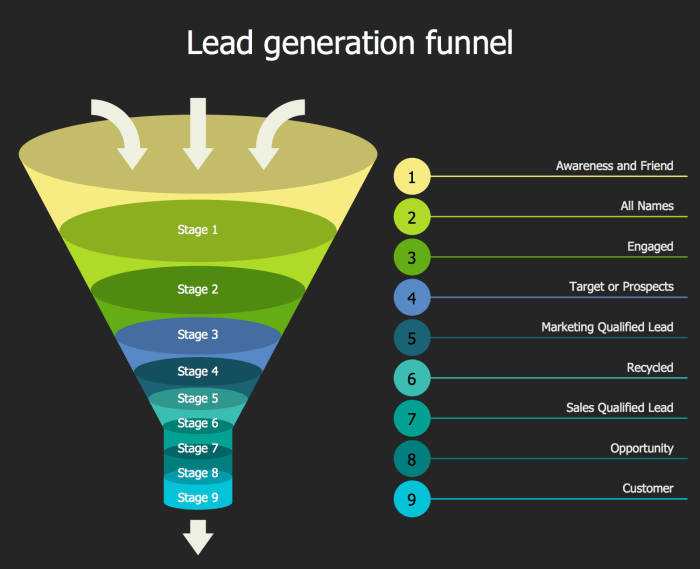
In order to successfully guide leads through the lead generation funnel, implementing effective Call-to-Actions (CTAs) is crucial. CTAs play a significant role in prompting action from potential leads and converting them into customers. They act as signposts that direct users on what steps to take next, ultimately driving them towards the desired outcome.
Role of CTAs in Guiding Leads Through the Funnel
CTAs serve as the bridge between engaging content and desired actions. By strategically placing CTAs at key points in the funnel, marketers can influence the decision-making process of leads. These prompts encourage users to take specific actions, such as signing up for a newsletter, requesting a demo, or making a purchase. By guiding leads through the funnel with well-crafted CTAs, businesses can effectively nurture relationships and increase conversion rates.
Best Practices for Creating Compelling CTAs
- Use action-oriented language that compels users to act immediately.
- Create a sense of urgency by incorporating phrases like “Limited Time Offer” or “Act Now.”
- Ensure CTAs are visually appealing and stand out on the page.
- Keep CTAs concise and clear, avoiding jargon or ambiguity.
- A/B test different variations of CTAs to determine which ones resonate best with your audience.
Strategically Placing CTAs Across Different Marketing Channels
Placing CTAs strategically across various marketing channels is key to maximizing their effectiveness. Whether it’s on a website, social media platform, email campaign, or digital ad, CTAs should be tailored to fit the specific context and audience. By aligning CTAs with the user’s journey and providing relevant prompts at the right time, businesses can enhance engagement and drive desired actions. It’s essential to analyze user behavior and adjust CTAs accordingly to optimize conversion rates.
Nurturing Leads with Email Marketing
Email marketing plays a crucial role in nurturing leads along the sales funnel. It allows businesses to maintain communication with potential customers, build relationships, and guide them towards making a purchase. By delivering personalized and relevant content directly to their inbox, email marketing helps to keep leads engaged and informed about products or services.
Importance of Email Marketing in Nurturing Leads
- Email marketing enables targeted communication: By segmenting leads based on their interests, behavior, or demographics, businesses can send tailored messages that resonate with each group.
- Building credibility and trust: Consistent email communication helps to establish credibility and trust with leads over time, making them more likely to consider a purchase.
- Driving conversions: Well-crafted email campaigns can influence leads to take action, whether it’s signing up for a webinar, downloading a resource, or making a purchase.
Tips for Creating Engaging Email Content that Converts
- Personalize the content: Address leads by their name and tailor the messaging based on their preferences and past interactions with your brand.
- Create compelling subject lines: Grab the attention of leads with captivating subject lines that entice them to open the email and engage with the content.
- Include relevant visuals: Use images, videos, and infographics to make the email visually appealing and convey information more effectively.
- Provide valuable content: Offer useful tips, insights, or exclusive offers that provide value to the leads and keep them interested in your emails.
Automating Email Workflows for Lead Nurturing
- Set up automated drip campaigns: Create a series of emails that are automatically sent to leads based on their actions or stage in the buying process, keeping them engaged and moving them towards conversion.
- Use marketing automation tools: Implement tools that allow you to track lead behavior, personalize emails, and schedule automated campaigns for efficient lead nurturing.
- Analyze and optimize: Monitor the performance of your email campaigns, track open rates, click-through rates, and conversion metrics to identify what works best and optimize your workflows for better results.
Analyzing and Optimizing Funnel Performance

Analyzing and optimizing the performance of a lead generation funnel is crucial for maximizing conversions and improving ROI. By tracking key metrics, utilizing tools for analysis, and implementing A/B testing, businesses can identify areas for improvement and enhance overall funnel effectiveness.
Key Metrics for Evaluating Funnel Success, Creating a successful lead generation funnel
- Conversion Rate: The percentage of visitors who take the desired action, such as signing up or making a purchase.
- Cost per Lead: The amount spent on acquiring a lead, calculated by dividing total marketing expenses by the number of leads generated.
- Lead Quality: The relevance and potential of leads generated in terms of their likelihood to convert into customers.
- Customer Acquisition Cost (CAC): The total cost incurred to acquire a new customer, including marketing and sales expenses.
Tools and Techniques for Analyzing Funnel Performance
- Google Analytics: Track website traffic, user behavior, and conversion rates to gain insights into funnel performance.
- CRM Systems: Integrate customer relationship management systems to monitor lead interactions and progression through the funnel.
- Heatmaps and Session Recordings: Visualize user interactions on the website to identify bottlenecks and areas for optimization.
Strategies for A/B Testing and Optimization
- Test Different CTAs: Experiment with variations in call-to-action buttons, copy, and placement to determine which drives higher conversions.
- Optimize Landing Pages: Make data-driven changes to landing page design, content, and forms to improve user engagement and lead capture.
- Email Campaign Testing: Conduct A/B tests on subject lines, content, and send times to enhance email open rates and click-through rates.
Conclusion
In conclusion, mastering the art of creating a successful lead generation funnel is a dynamic process that requires continuous refinement and analysis. By following the strategies Artikeld in this guide, businesses can elevate their lead generation efforts and drive meaningful results.
Utilizing Google Analytics for data-driven decisions is crucial for businesses looking to improve their online presence. By analyzing website traffic, user behavior, and conversion rates, companies can make informed decisions to optimize their digital marketing efforts. To learn more about how Google Analytics can help your business, check out this article on Utilizing Google Analytics for data-driven decisions.
Small businesses can benefit greatly from implementing effective digital marketing strategies. From social media marketing to search engine optimization, there are various techniques that can help small businesses reach their target audience and increase brand awareness. For more insights on digital marketing strategies for small businesses, you can refer to this informative article on Digital marketing strategies for small businesses.
Choosing the right server colocation provider is essential for businesses looking to ensure reliable and secure hosting services. With a range of options available, it is crucial to compare factors such as uptime, security measures, and scalability. To explore the top server colocation providers in the industry, you can refer to this comprehensive guide on Top server colocation providers.
